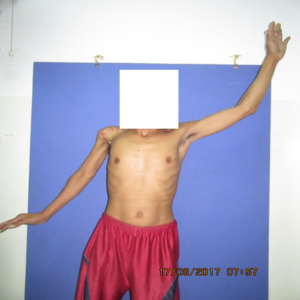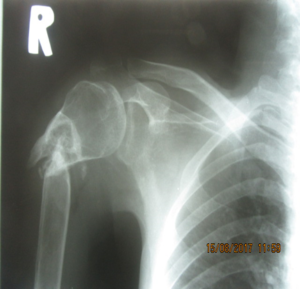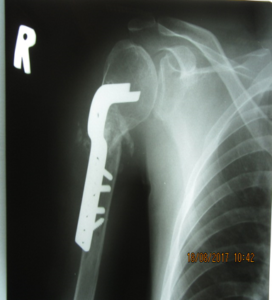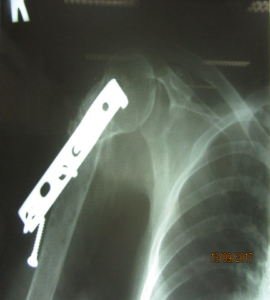

History: A 34 year old male had a right femur and right humerus open fracture in January 2016. His initial treatment included an amputation of his leg and external fixator of humerus. He presented to CSC in August 2017. His initial clinical examination and x-rays demonstrated obvious non-union of his humerus, as shown by the images above.
On 17th August, at CSC he had a blade plate and bone grafting. This is shown in the x-ray below.

However, by four weeks post op, the metalwork had displaced, as seen below:

Dr Saqib: Learning point 1: Before we understand non-union it is important to understand the physiology of union after a fracture. Most of us are aware of the process of fracture healing – haematoma, inflammation, soft callus, hard callus and remodelling. However, this is only one way a fracture heals and is known as secondary fracture healing. There is also a process called primary fracture healing, when callus does not form but the bone heals. This occurs when the bone gap is completely reduced and minimal strain occurs through the fracture – in other words, anatomical reduction, compression and absolute stability.
This video nicely describes primary and secondary bone healing.
When we are fixing fractures, it is important to to understand what type of healing we are trying to achieve. Certainly articular fractures should aim for primary bone healing with no callus, and therefore we need anatomical reduction and absolute stability.
Dr Saqib: Learning point 2: Once you have understood the mechanism of bone healing, it is important to understand why bone does not heal – in other words, what is the causes of non-union. It can be divided into two main causes – the stability of the fracture and the biology of the fracture. The stability is dependent on the fracture configuration, reduction and immobilisation method – whether that is traction, sling, plaster, external fixation or different types of internal fixation.
The biology is dependent on the blood supply to the fracture and can be affected by excessive periosteal stripping, infection or patient factors such as smoking, diabetes, vascular disease, drug and steroid use etc etc
You can also define a non-union as either hypertrophic or atrophic, depending on whether callus has formed or not.
Dr Saqib: Learning point 3:
Dr Saqib: Learning point 4: